Abstract
On occasion, a patient may have two or more clinical cultures yielding a coagulase-negative staphylococcus If these multiple isolates have the same phenotype, one might conclude that the same strain was reisolated from the patient, indicating its persistent and pathological presence. We examined the validity of this conclusion when we applied a number of characterizing systems to a collection of 143 isolates of coagulase-negative staphylococci collected during an outbreak of intravascular catheter-associated sepsis. The probability of classifying two random isolates as the same phenotype or species was as follows: P = 0.356 for phage typing, P = 0.348 for Baird-Parker biotyping, P = 0.346 for the API STAPH-IDENT (Analytab Products) system, P = 0.327 for Bentley et al. biotyping, and P = 0.077 for antimicrobial susceptibility patterns. Although antimicrobial susceptibility patterns had the lowest probability, a variability in test results of 7.7% and a tendency for strains to have similar antibiograms effectively raised the probability to P = 0.897. The combination of the API STAPH-IDENT with antibiograms resulted in a probability of P = 0.037 to P = 0.147. When all of the above methods were used together a probability of P = 0.014 was achieved. Five patients had isolates from two or more blood cultures spaced more than 1 day apart that were identical by all of the above criteria, thus confirming prolonged bacteremia. The collection was also examined for the incidence of slime production. Slime production was not associated with any of the above groups, but was associated with symptomatic infections (P less than 0.05) and gentamicin resistance (P less than 0.01). Slime production was strain stable and was of assistance in typing strains of coagulase-negative staphylococci.
Full text
PDF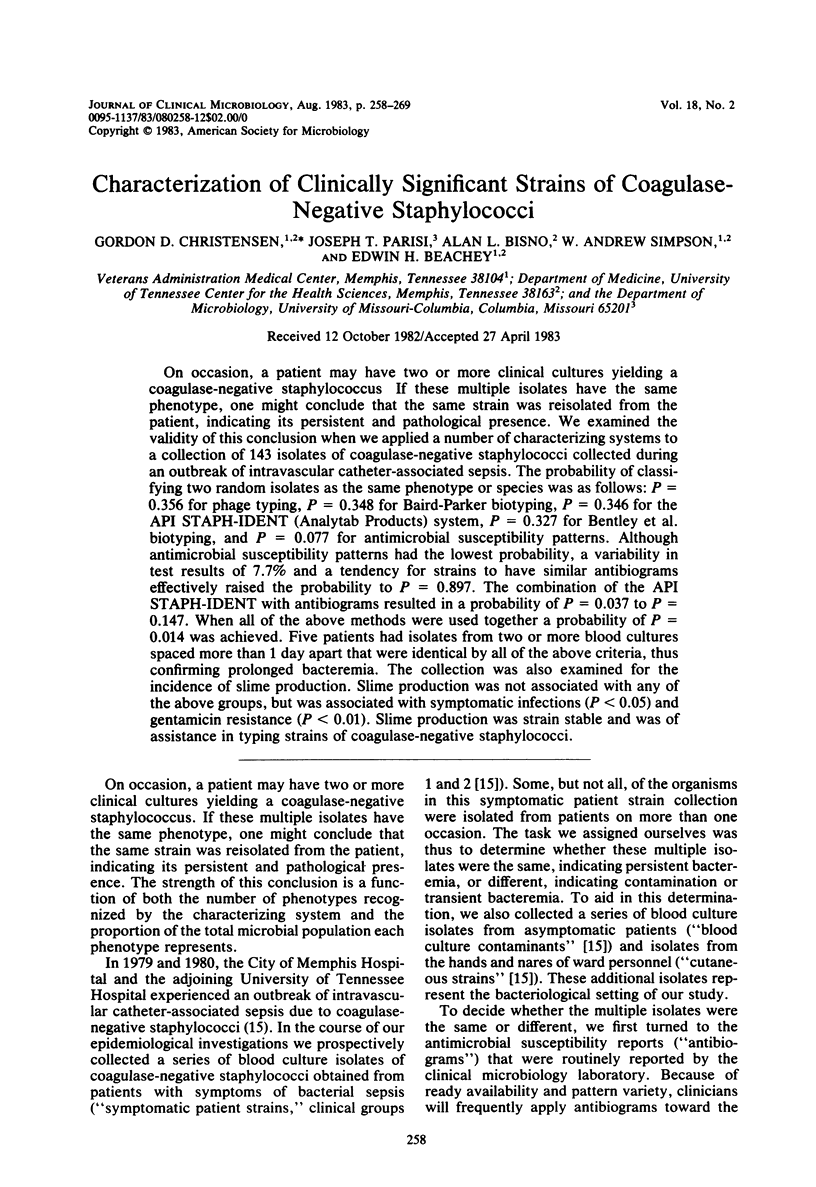


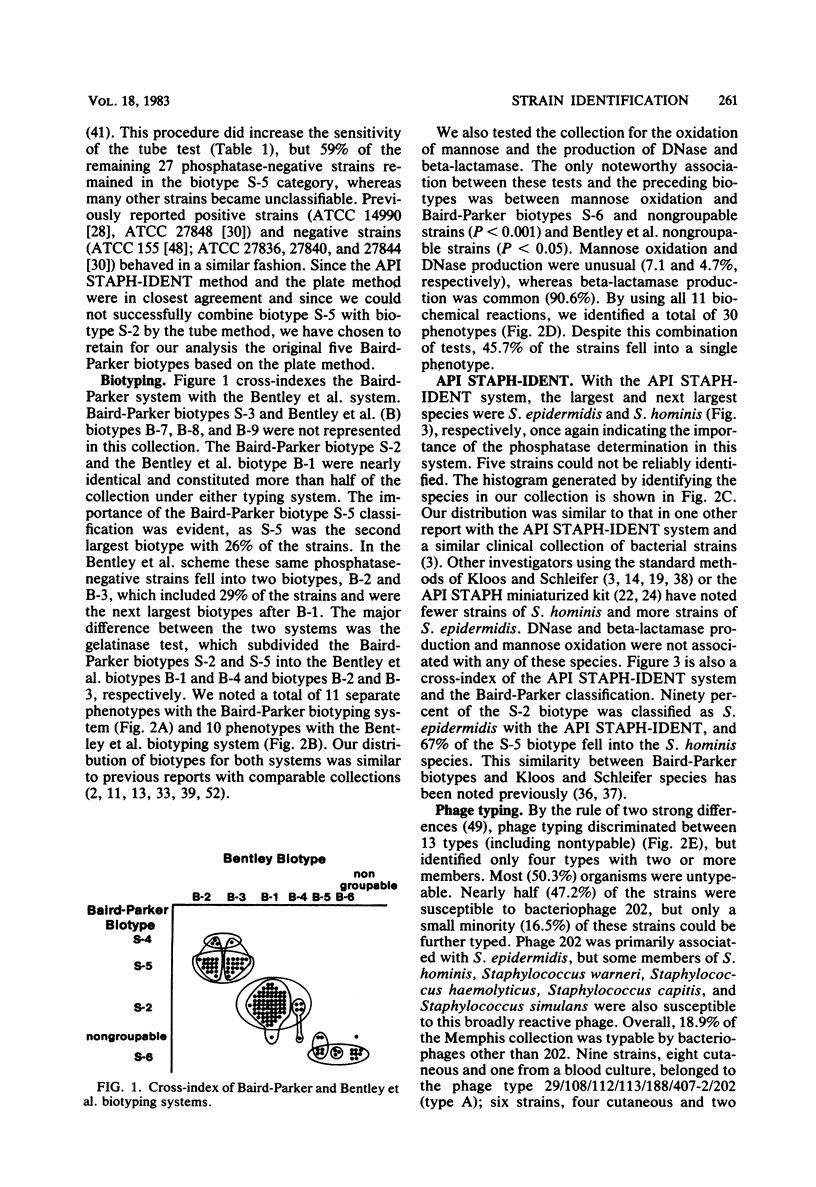

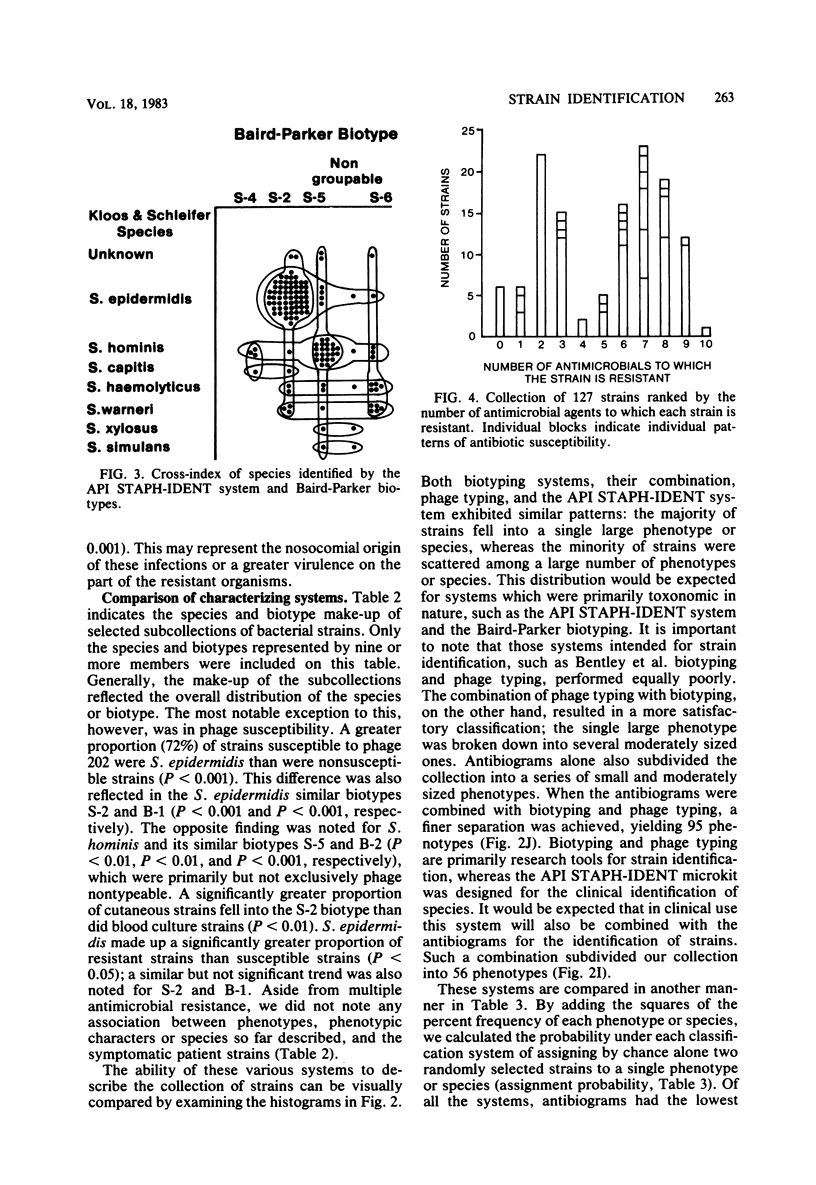
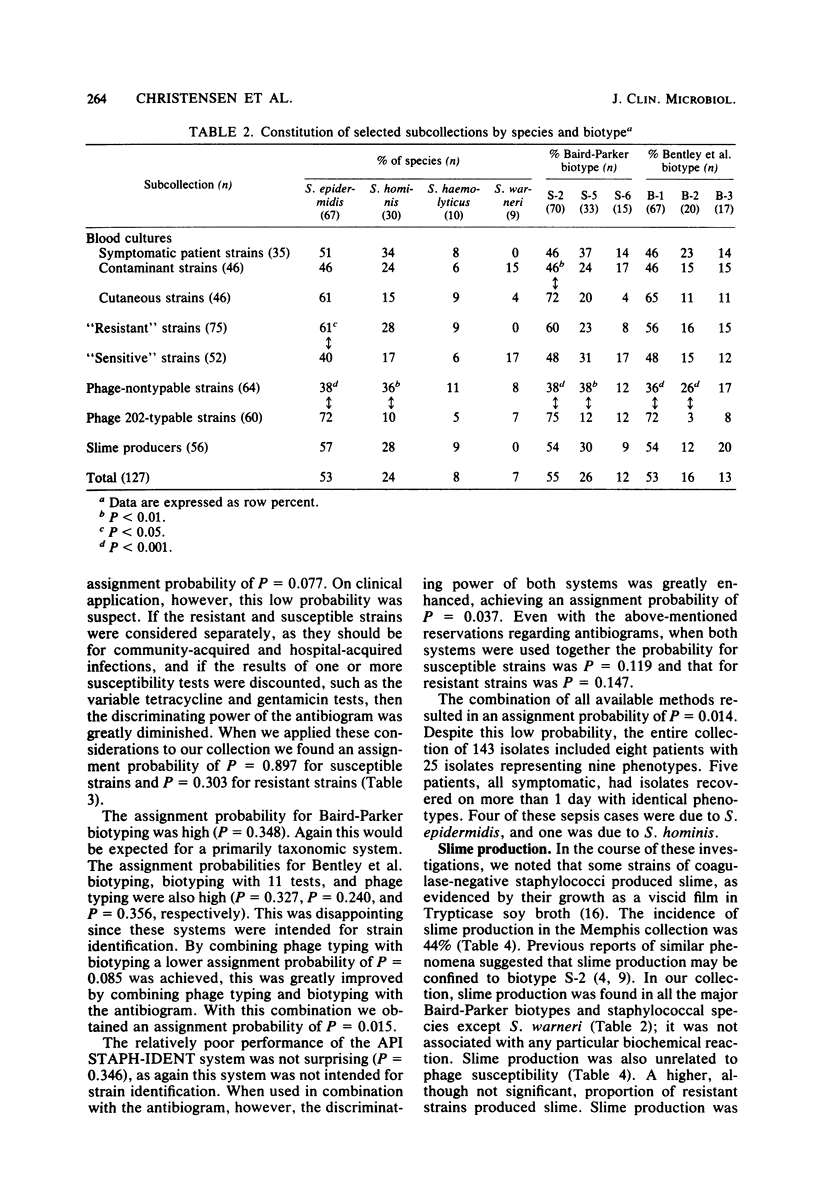
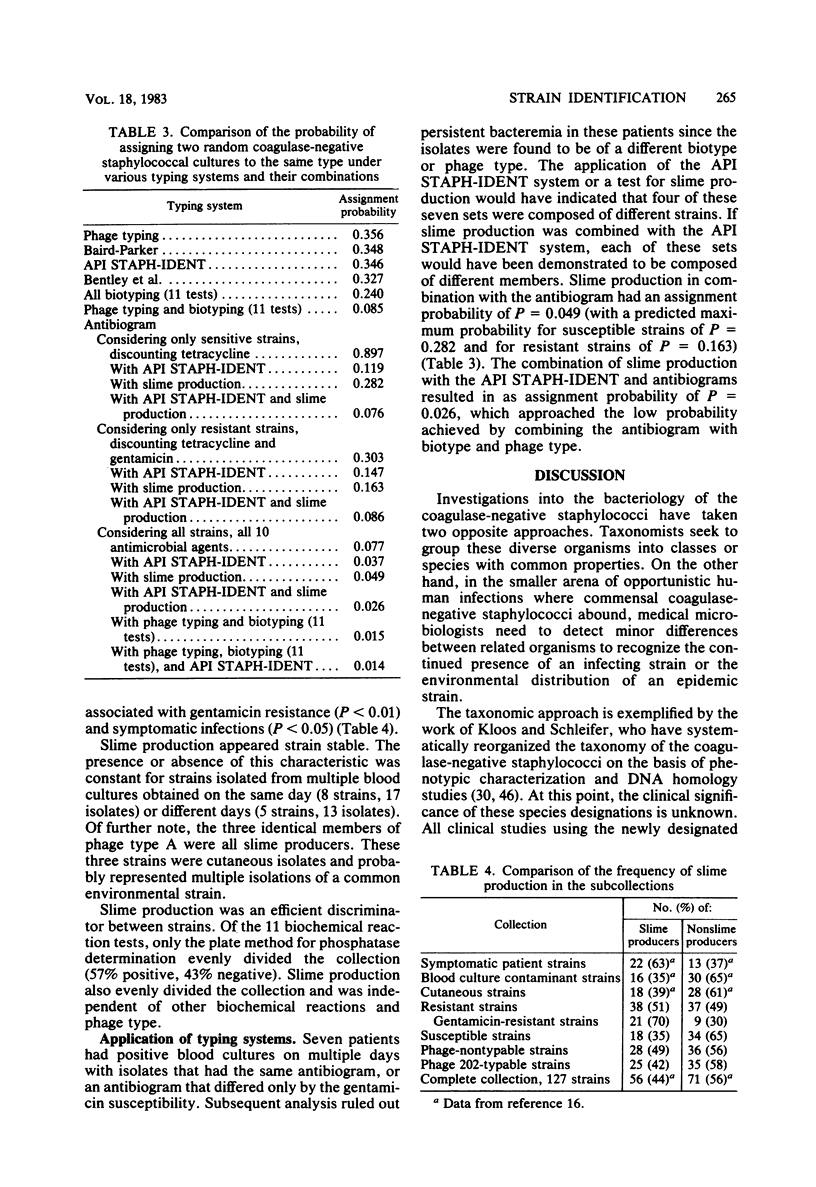
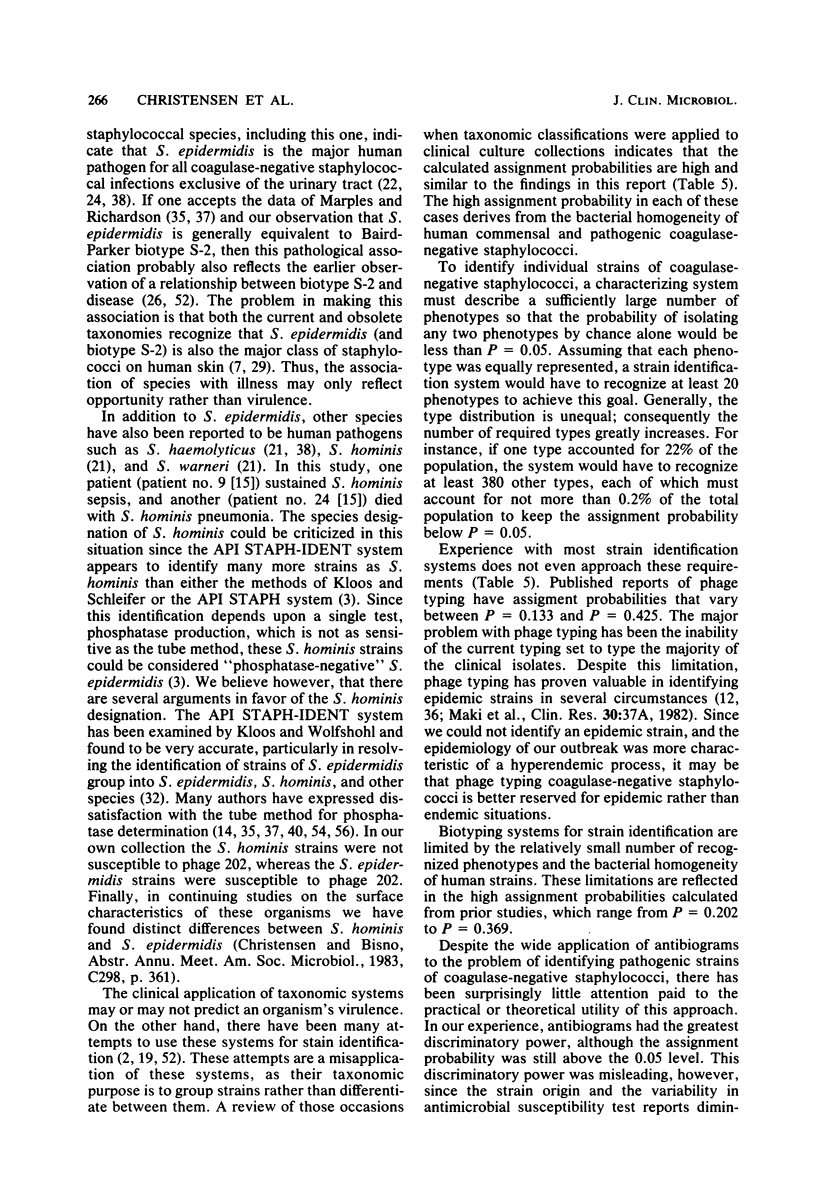
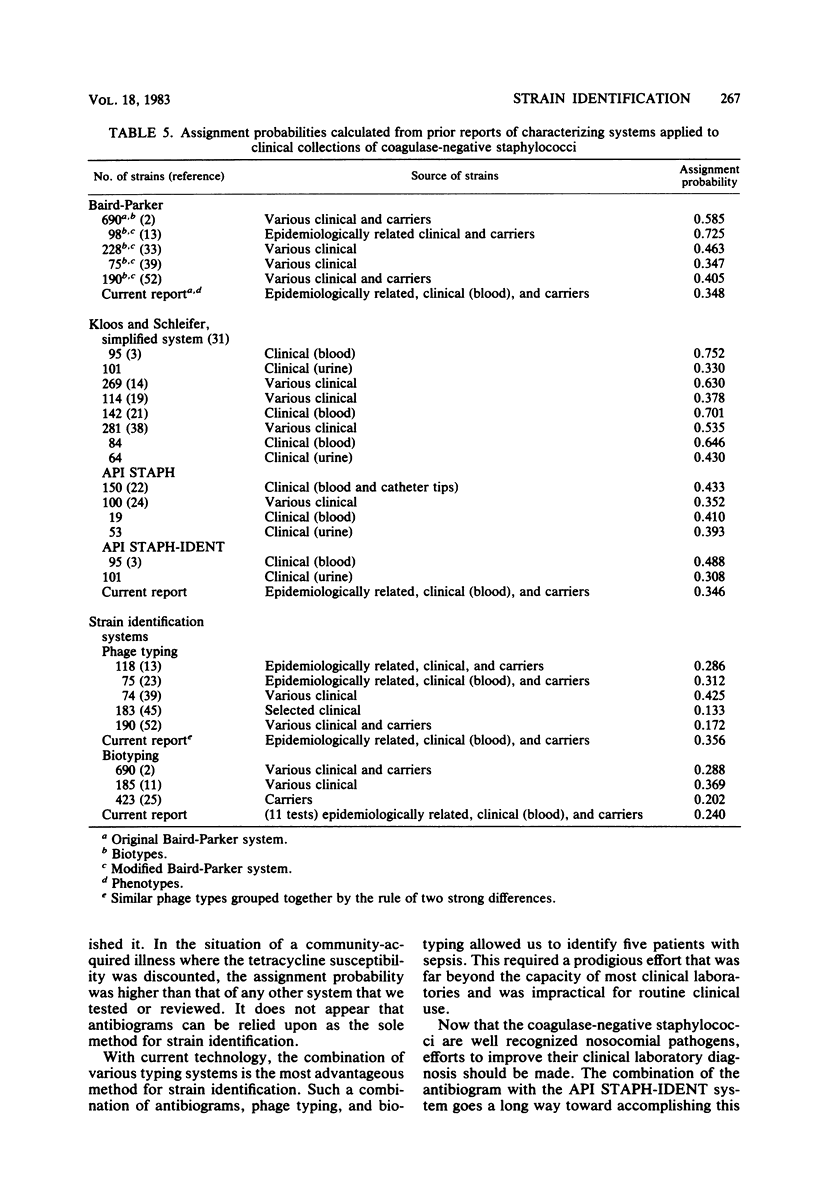
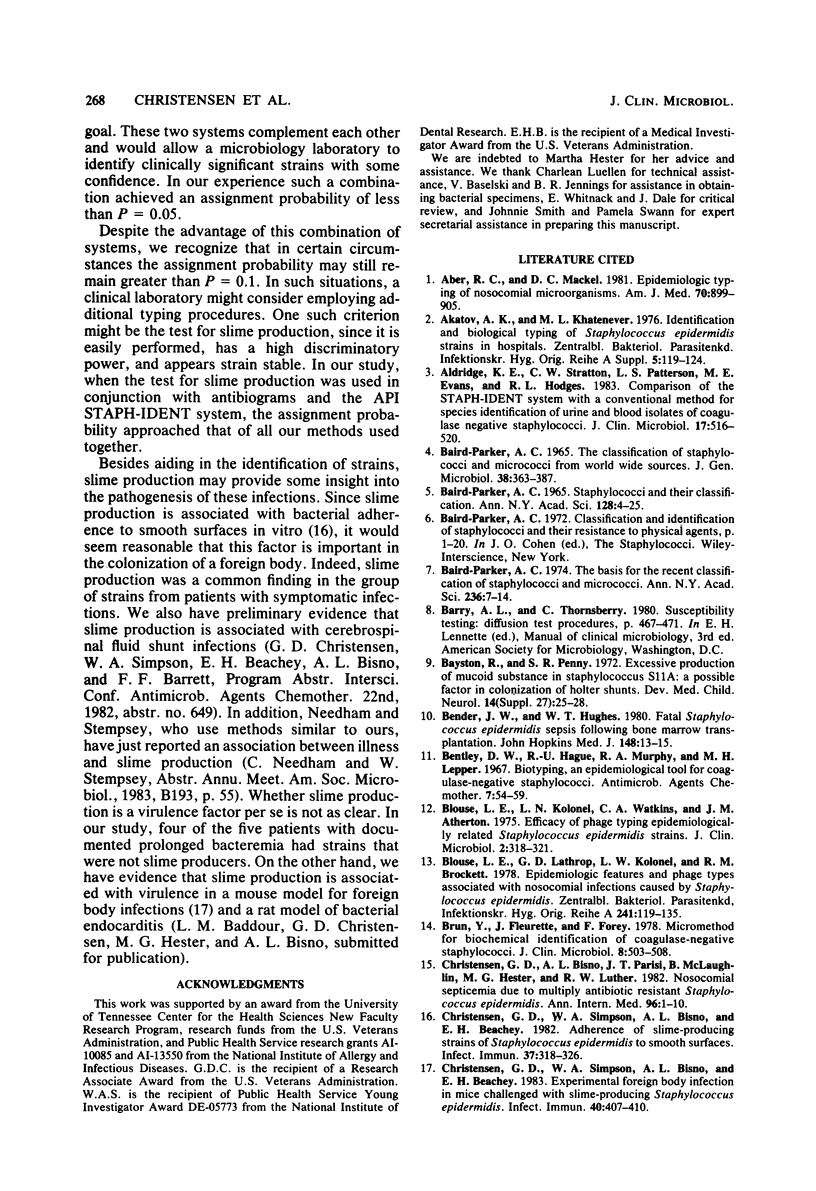

Selected References
These references are in PubMed. This may not be the complete list of references from this article.
- Aber R. C., Mackel D. C. Epidemiologic typing of nosocomial microorganisms. Am J Med. 1981 Apr;70(4):899–905. doi: 10.1016/0002-9343(81)90552-0. [DOI] [PubMed] [Google Scholar]
- Aldridge K. E., Stratton C. W., Patterson L. S., Evans M. E., Hodges R. L. Comparison of the Staph-Ident system with a conventional method for species identification of urine and blood isolates of coagulase-negative staphylococci. J Clin Microbiol. 1983 Mar;17(3):516–520. doi: 10.1128/jcm.17.3.516-520.1983. [DOI] [PMC free article] [PubMed] [Google Scholar]
- BAIRD-PARKER A. C. THE CLASSIFICATION OF STAPHYLOCOCCI AND MICROCOCCI FROM WORLD-WIDE SOURCES. J Gen Microbiol. 1965 Mar;38:363–387. doi: 10.1099/00221287-38-3-363. [DOI] [PubMed] [Google Scholar]
- Baird-Parker A. C. Staphylococci and their classification. Ann N Y Acad Sci. 1965 Jul 23;128(1):4–25. doi: 10.1111/j.1749-6632.1965.tb11626.x. [DOI] [PubMed] [Google Scholar]
- Baird-Parker A. C. The basis for the present classification of staphylococci and micrococci. Ann N Y Acad Sci. 1974 Jul 31;236(0):7–14. doi: 10.1111/j.1749-6632.1974.tb41478.x. [DOI] [PubMed] [Google Scholar]
- Bayston R., Penny S. R. Excessive production of mucoid substance in staphylococcus SIIA: a possible factor in colonisation of Holter shunts. Dev Med Child Neurol Suppl. 1972;27:25–28. doi: 10.1111/j.1469-8749.1972.tb09769.x. [DOI] [PubMed] [Google Scholar]
- Bender J. W., Hughes W. T. Fatal Staphylococcus epidermidis sepsis following bone marrow transplantation. Johns Hopkins Med J. 1980 Jan;146(1):13–15. [PubMed] [Google Scholar]
- Bentley D. W., Haque R. U., Murphy R. A., Lepper M. H. Biotyping, and epidemiological tool for coagulase-negative staphylococci. Antimicrob Agents Chemother (Bethesda) 1967;7:54–59. [PubMed] [Google Scholar]
- Blouse L. E., Lathrop G. D., Kolonel L. N., Brockett R. M. Epidemiologic features and phage types associated with nosocomial infections caused by Staphylococcus epidermidis. Zentralbl Bakteriol Orig A. 1978 Jul;241(1):119–135. [PubMed] [Google Scholar]
- Blouse L., Kolonel L. N., Watkins C. A., Atherton J. M. Efficacy of phage typing epidemiologically related Staphylococcus epidermidis strains. J Clin Microbiol. 1975 Oct;2(4):318–321. doi: 10.1128/jcm.2.4.318-321.1975. [DOI] [PMC free article] [PubMed] [Google Scholar]
- Brun Y., Fleurette J., Forey F. Micromethod for biochemical identification of coagulase-negative staphylococci. J Clin Microbiol. 1978 Nov;8(5):503–508. doi: 10.1128/jcm.8.5.503-508.1978. [DOI] [PMC free article] [PubMed] [Google Scholar]
- Christensen G. D., Bisno A. L., Parisi J. T., McLaughlin B., Hester M. G., Luther R. W. Nosocomial septicemia due to multiply antibiotic-resistant Staphylococcus epidermidis. Ann Intern Med. 1982 Jan;96(1):1–10. doi: 10.7326/0003-4819-96-1-1. [DOI] [PubMed] [Google Scholar]
- Christensen G. D., Simpson W. A., Bisno A. L., Beachey E. H. Adherence of slime-producing strains of Staphylococcus epidermidis to smooth surfaces. Infect Immun. 1982 Jul;37(1):318–326. doi: 10.1128/iai.37.1.318-326.1982. [DOI] [PMC free article] [PubMed] [Google Scholar]
- Christensen G. D., Simpson W. A., Bisno A. L., Beachey E. H. Experimental foreign body infections in mice challenged with slime-producing Staphylococcus epidermidis. Infect Immun. 1983 Apr;40(1):407–410. doi: 10.1128/iai.40.1.407-410.1983. [DOI] [PMC free article] [PubMed] [Google Scholar]
- Connors J. M. Cure of Ommaya reservoir associated Staphylococcus epidermidis ventriculitis with a simple regimen of vancomycin and rifampin without reservoir removal. Med Pediatr Oncol. 1982;10(6):549–552. doi: 10.1002/mpo.2950100603. [DOI] [PubMed] [Google Scholar]
- Doern G. V., Earls J. E., Jeznach P. A., Parker D. S. Species identification and biotyping of staphylococci by the API staph-ident system. J Clin Microbiol. 1983 Feb;17(2):260–263. doi: 10.1128/jcm.17.2.260-263.1983. [DOI] [PMC free article] [PubMed] [Google Scholar]
- Ebright J. R., Rytel M. W. Intra-abdominal abscess caused by Staphylococcus epidermidis. Arch Surg. 1980 Mar;115(3):326–326. doi: 10.1001/archsurg.1980.01380030072017. [DOI] [PubMed] [Google Scholar]
- Eng R. H., Wang C., Person A., Kiehn T. E., Armstrong D. Species identification of coagulase-negative staphylococcal isolates from blood cultures. J Clin Microbiol. 1982 Mar;15(3):439–442. doi: 10.1128/jcm.15.3.439-442.1982. [DOI] [PMC free article] [PubMed] [Google Scholar]
- Freeman R., Hjersing N. Species of coagulase-negative staphylococci isolated from catheter tips from open-heart surgery patients. Thorax. 1980 May;35(5):359–362. doi: 10.1136/thx.35.5.359. [DOI] [PMC free article] [PubMed] [Google Scholar]
- Fridhandler I., Gill P., Martinez L., Vas S. I. Comparison of "invasive" and "non-invasive" strains of Staphylococcus epidermidis by phage typing. Zentralbl Bakteriol Orig A. 1978 Jul;241(1):136–139. [PubMed] [Google Scholar]
- Gemmell C. G., Dawson J. E. Identification of coagulase-negative staphylococci with the API staph system. J Clin Microbiol. 1982 Nov;16(5):874–877. doi: 10.1128/jcm.16.5.874-877.1982. [DOI] [PMC free article] [PubMed] [Google Scholar]
- Holt R. The classification of staphylococci from colonized ventriculo-atrial shunts. J Clin Pathol. 1969 Jul;22(4):475–482. doi: 10.1136/jcp.22.4.475. [DOI] [PMC free article] [PubMed] [Google Scholar]
- JONES D., DEIBEL R. H., NIVEN C. F., Jr Identity of Staphylococcus epidermidis. J Bacteriol. 1963 Jan;85:62–67. doi: 10.1128/jb.85.1.62-67.1963. [DOI] [PMC free article] [PubMed] [Google Scholar]
- Jefferson S. J., Parisi J. T. Bacteriophage typing of coagulase-negative staphylococci. J Clin Microbiol. 1979 Sep;10(3):396–397. doi: 10.1128/jcm.10.3.396-397.1979. [DOI] [PMC free article] [PubMed] [Google Scholar]
- Kloos W. E., Musselwhite M. S. Distribution and persistence of Staphylococcus and Micrococcus species and other aerobic bacteria on human skin. Appl Microbiol. 1975 Sep;30(3):381–385. doi: 10.1128/am.30.3.381-395.1975. [DOI] [PMC free article] [PubMed] [Google Scholar]
- Kloos W. E., Schleifer K. H. Simplified scheme for routine identification of human Staphylococcus species. J Clin Microbiol. 1975 Jan;1(1):82–88. doi: 10.1128/jcm.1.1.82-88.1975. [DOI] [PMC free article] [PubMed] [Google Scholar]
- Kloos W. E., Wolfshohl J. F. Identification of Staphylococcus species with the API STAPH-IDENT system. J Clin Microbiol. 1982 Sep;16(3):509–516. doi: 10.1128/jcm.16.3.509-516.1982. [DOI] [PMC free article] [PubMed] [Google Scholar]
- Males B. M., Rogers W. A., Jr, Parisi J. T. Virulence factors of biotypes of Staphylococcus epidermidis from clinical sources. J Clin Microbiol. 1975 Mar;1(3):256–261. doi: 10.1128/jcm.1.3.256-261.1975. [DOI] [PMC free article] [PubMed] [Google Scholar]
- Mancusi-Ungaro H. R., Jr Treatment of necrotizing fasciitis caused by Staphylococcus epidermidis. Arch Surg. 1978 Mar;113(3):288–288. doi: 10.1001/archsurg.1978.01370150060011. [DOI] [PubMed] [Google Scholar]
- Marples R. R., Hone R., Notley C. M., Richardson J. F., Crees-Morris J. A. Ivestigation of coagulase-negative staphylococci from infections in surgical patients. Zentralbl Bakteriol Orig A. 1978 Jul;241(1):140–156. [PubMed] [Google Scholar]
- Marples R. R., Richardson J. F. Evaluation of a micromethod gallery (API Staph) for the identification of staphylococci and micrococci. J Clin Pathol. 1982 Jun;35(6):650–656. doi: 10.1136/jcp.35.6.650. [DOI] [PMC free article] [PubMed] [Google Scholar]
- Marsik F. J., Brake S. Species identification and susceptibility to 17 antibiotics of coagulase-negative staphylococci isolated from clinical specimens. J Clin Microbiol. 1982 Apr;15(4):640–645. doi: 10.1128/jcm.15.4.640-645.1982. [DOI] [PMC free article] [PubMed] [Google Scholar]
- Natesan V., Mohapatra L. N., Bhujwala R. A. Biotypes, antibiogram and phage types of Staphylococcus epidermis of human origin. Indian J Pathol Microbiol. 1980 Jul;23(3):199–204. [PubMed] [Google Scholar]
- Oeding P., Digranes A. Classification of coagulase-negative staphylococci in the diagnostic laboratory. Acta Pathol Microbiol Scand B. 1977 Apr;85(2):136–142. doi: 10.1111/j.1699-0463.1977.tb01687.x. [DOI] [PubMed] [Google Scholar]
- PAL S. C., RAY B. G. Phosphatase activity of pathogenic staphylococci. Indian J Med Sci. 1962 Jun;16:516–519. [PubMed] [Google Scholar]
- Parisi J. T., Hecht D. W. Plasmid profiles in epidemiologic studies of infections by Staphylococcus epidermidis. J Infect Dis. 1980 May;141(5):637–643. doi: 10.1093/infdis/141.5.637. [DOI] [PubMed] [Google Scholar]
- Parisi J. T., Talbot H. W., Skahan J. M. Development of a phage typing set for Staphylococcus epidermidis in the United States. Zentralbl Bakteriol Orig A. 1978 Jul;241(1):60–67. [PubMed] [Google Scholar]
- Pennock C. A., Huddy R. B. Phosphatase reaction of coagulase-negative staphylococci and micrococci. J Pathol Bacteriol. 1967 Apr;93(2):685–688. doi: 10.1002/path.1700930231. [DOI] [PubMed] [Google Scholar]
- Pulverer G., Pillich J., Klein A. New bacteriophages of Staphylococcus epidermidis. J Infect Dis. 1975 Nov;132(5):524–531. doi: 10.1093/infdis/132.5.524. [DOI] [PubMed] [Google Scholar]
- Skahan J. M., Parisi J. T. Development of a bacteriophage-typing set for Staphylococcus epidermidis. J Clin Microbiol. 1977 Jul;6(1):16–18. doi: 10.1128/jcm.6.1.16-18.1977. [DOI] [PMC free article] [PubMed] [Google Scholar]
- Smith H. B., Farkas-Himsley H. The relationship of pathogenic coagulase-negative staphylococci to Staphylococcus aureus. Can J Microbiol. 1969 Aug;15(8):879–890. doi: 10.1139/m69-157. [DOI] [PubMed] [Google Scholar]
- Talbot H. W., Jr, Parisi J. T. Phage typing of Staphylococcus epidermidis. J Clin Microbiol. 1976 May;3(5):519–523. doi: 10.1128/jcm.3.5.519-523.1976. [DOI] [PMC free article] [PubMed] [Google Scholar]
- Tselenis-Kotsowilis A., Dimitracopoulos G., Papavassiliou J. A comparative study of Staphylococcus epidermidis isolates from clinical material and healthy carriers. Zentralbl Bakteriol Orig A. 1978 Jul;241(1):101–107. [PubMed] [Google Scholar]
- Verhoef J., Van Boven C. P., Winkler K. C. Phage-typing of coagulase-negative staphylococci. J Med Microbiol. 1972 Feb;5(1):9–19. doi: 10.1099/00222615-5-1-9. [DOI] [PubMed] [Google Scholar]
- Wilkinson B. J., Maxwell S., Schaus S. M. Classification and characteristics of coagulase-negative, methicillin-resistant staphylococci. J Clin Microbiol. 1980 Aug;12(2):161–166. doi: 10.1128/jcm.12.2.161-166.1980. [DOI] [PMC free article] [PubMed] [Google Scholar]


